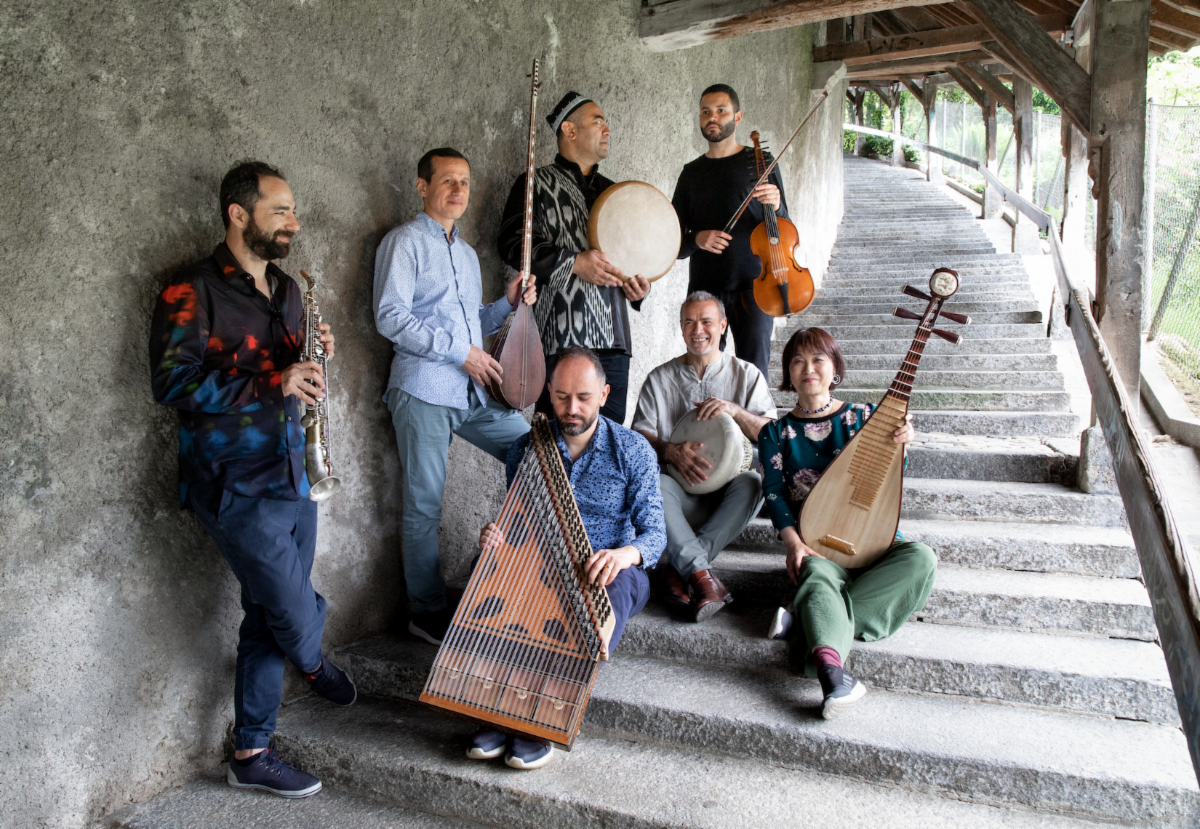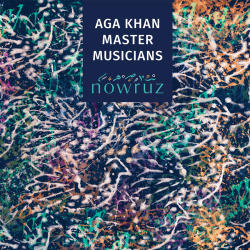|
Zigzagging musical journeys of group’s members converge into funky, eclectic expressions of Muslim musical heritage - pre-order Nowruz HERE
|
|
|
LISTEN: First Single "Tashkent" Out Today
|
|
Aga Khan Master Musicians, the musical collective that was established in 2013 to support contemporary expressions of Muslim musical heritage, will release their debut album, Nowruz, on October 13th, 2023 (Smithsonian Folkways).
A twelve-track LP of new music inspired by old traditions, Nowruz's sources of inspiration arise from the eclectic backgrounds and zigzagging musical journeys of the Master Musicians' members. Offering a synoptic overview of those journeys - from the musicians’ origins in the Middle East, Central Asia, and China to their convergence in the funky recording studio in Switzerland where this album came together —Nowruz is the culmination of a decade of fervent musical experimentation and uninhibited creative search. Named for the Persian New Year, the album celebrates the rebirth and renewal of the many traditions that the Aga Khan Master Musicians uphold and hold dear.
Pre-order Nowruz on Smithsonian Folkways HERE, and listen to first single "Tashkent," out today HERE.
Read on for background on The Aga Khan Master Musicians, and their journey to Nowruz:
Founded in 2013 by the Aga Khan Music Programme, whose mission is to support contemporary expressions of Muslim musical heritage, the Aga Khan Master Musicians (AKMM) inhabits a space of temporal, geographic, and artistic liminality in which East and West, present and past, and folk, jazz, and classical music both Western and non-Western nourish a strikingly original body of work.
AKMM’s creative process is straightforward and democratic: all members contribute pieces they have composed, each piece typically featuring the composer's own instrument, and these pieces are subsequently arranged by the group. The arrangements evolve through successive performances and offer ample room for spontaneity and improvisation. Nowruz presents a selection of these ensemble pieces interspersed with solos and duets that showcase the sound of individual instruments in the hands of master performers. The combination of instruments in the ensemble pieces is unique. Which other group features saxophone, pipa, qanun, dutar, frame drum, viola d’amore and duclar—a recently invented hybrid that consists of a clarinet mouthpiece fitted to the body of a duduk?
Feras Charestan, a master performer on the qanun, a trapezoidal zither with roots in ancient Mesopotamia, is equally at home performing newly composed orchestral music as he is accompanying the traditional muwashshah singers of his native Syria. Likewise, Wu Man, the celebrated pipa maestra, moves seamlessly between the instrument’s canonical repertoire of solo pieces and a constellation of contemporary works for pipa and orchestra, pipa and string quartet, pipa and son jarocho ensemble, and, in the case of AKMM, pipa compositions in a musical language very much her own. On the rhythm side, Abbos Kosimov, who relocated from his native Uzbekistan to Sacramento, California, has put his peerless mastery of frame drums at the disposal of rock and pop icons, jazz musicians, and performers of Hindustani classical music in addition to playing with a wide range of performers from Central Asia.
|

Aga Khan Master Musicians (Photo Credit: Sebastian Schutyser)
|
|
|
The group’s instrumentation represents a kind of musical consanguinity that arcs back to antiquity when the trans-Eurasian trade routes commonly known as the Silk Road stimulated the cultural diffusion of lutes, viols, zithers, shawms, and drums whose origins are in the Middle East and Central Eurasia. The saxophone, of course, came later, patented by the Belgian instrument maker Antoine-Joseph “Adolphe” Sax in 1846. But Basel Rajoub, AKMM’s saxophonist, learned the instrument in Damascus, Syria, where jazz fused with the local maqam music performed on oud, violin, and qanun to create a new cosmopolitan sound. In this way, the saxophone became, if not a blood relative, then a relative by marriage of the lutes, viols, and zithers long associated with music from the Middle East.
The ancestry of the Chinese pipa, another seeming outlier in AKMM’s instrumentarium, has been traced back to Central Asia, from where it was evidently carried to China in ancient times. Thus, the pipa is a distant relative of the dutar, a long-necked lute with two strings that is a beloved instrument in the sedentary cultures of Central Asia and is represented in AKMM by the virtuosic playing of Tajik musician Sirojiddin Juraev. Similarly, the viola d’amore, an instrument associated with the Italian Baroque, is likely a descendant of the Middle Eastern rabab brought to medieval Andalusia by Arab conquerors. The gossamer timbre that Tunisian violinist Jasser Haj Youssef coaxes from the viola d’amore evokes a sui generis soundscape in which Baroque music and Arab maqam are congenial cohabitants.
Though the burnished sound of AKMM’s unlikely combination of instruments represents a singular voice in contemporary music, the group’s cosmopolitan approach to music-making is, thankfully, no longer exceptional. On the contrary, it has become an admired model for younger musicians as well as a social development tool for the Aga Khan Music Programme's cultural development initiatives. These days, the members of AKMM are much in demand as teachers and workshop leaders around the world. The meridian lines of their work with students and protégés as well as their own musical explorations follow from a fundamental shared belief: that tradition can serve as an invaluable compass for an artistic search into new forms of creativity inspired but not constrained by the past. The music on Nowruz is offered in gratitude to all who have helped the group broaden and deepen these explorations, and to the listeners whose enthusiastic response to AKMM’s work has encouraged them to continue their journey together.
|
|
|
About Smithsonian Folkways:
Smithsonian Folkways Recordings, the "National Museum of Sound," makes available close to 60,000 tracks in physical and digital format as the nonprofit record label of the Smithsonian, with a reach of 80 million people per year. A division of the Smithsonian Center for Folklife and Cultural Heritage, the non-profit label is dedicated to supporting cultural diversity and increased understanding among people through the documentation, preservation, production and dissemination of sound. Its mission is the legacy of Moses Asch, who founded Folkways Records in 1948 to document "people's music" from around the world. For more information about Smithsonian Folkways Recordings, visit folkways.si.edu.
For more information on Smithsonian Folkways Recordings, Follow Smithsonian Folkways:
Official website: folkways.si.edu
Facebook: facebook.com/smithsonianfolkwaysrecordings
Twitter: twitter.com/folkways
Instagram: instagram.com/smithsonianfolkways
|
|


